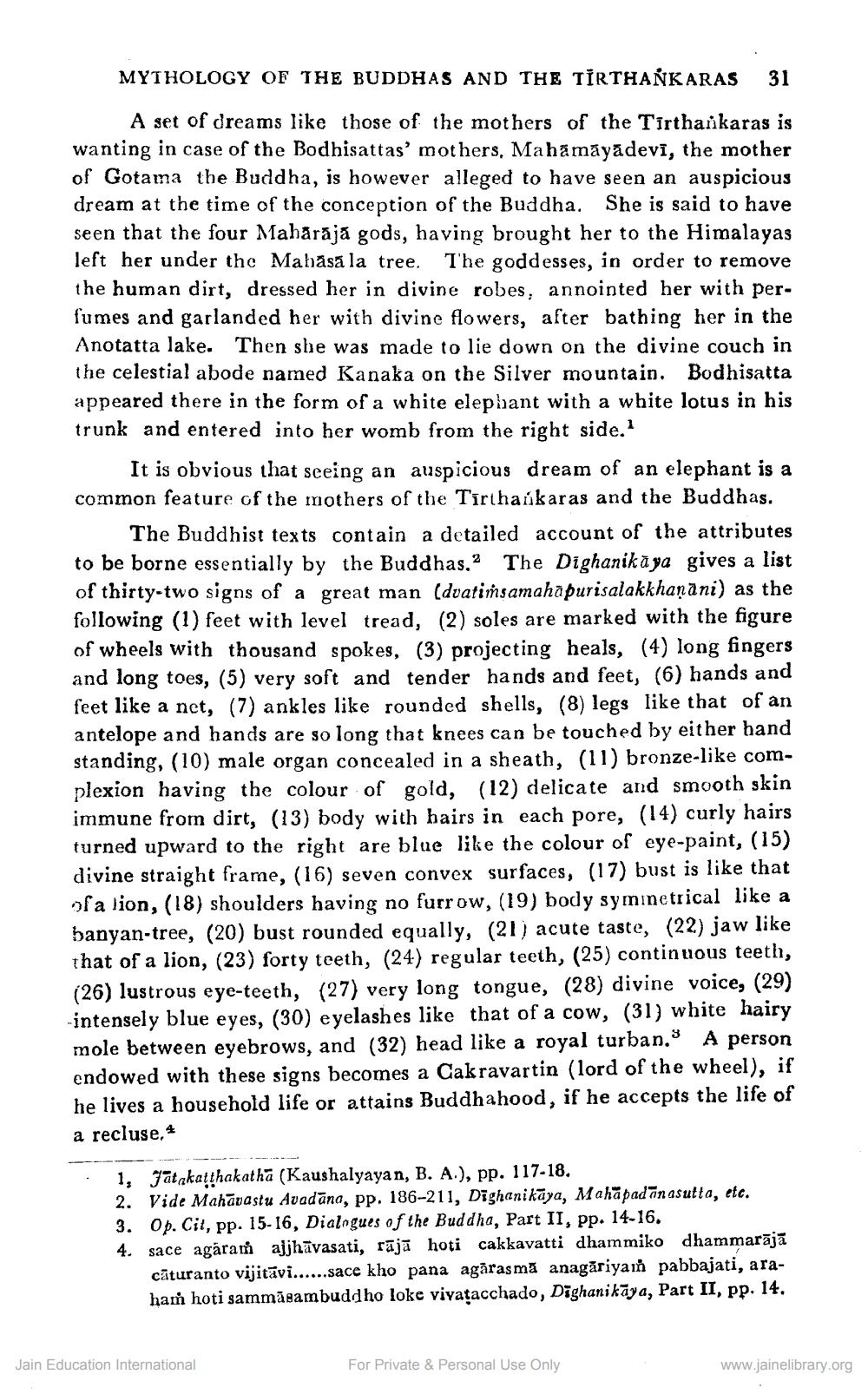________________
MYTHOLOGY OF THE BUDDHAS AND THE TIRTHANKARAS 31
A set of dreams like those of the mothers of the Tirtharkaras is wanting in case of the Bodhisattas' mothers, Mahāmāyadevī, the mother of Gotama the Buddha, is however alleged to have seen an auspicious dream at the time of the conception of the Buddha. She is said to have seen that the four Maharaja gods, having brought her to the Himalayas left her under the Mahasa la tree. The goddesses, in order to remove the human dirt, dressed her in divine robes, annointed her with perfumes and garlanded her with divine flowers, after bathing her in the Anotatta lake. Then she was made to lie down on the divine couch in the celestial abode named Kanaka on the Silver mountain. Bodhisatta appeared there in the form of a white elephant with a white lotus in his trunk and entered into her womb from the right side."
It is obvious that seeing an auspicious dream of an elephant is a common feature of the mothers of the Tirthaikaras and the Buddhas.
The Buddhist texts contain a detailed account of the attributes to be borne essentially by the Buddhas,2 The Dighanikāya gives a list of thirty-two signs of a great man (dvatimsamahapurisalakkhaṇāni) as the following (1) feet with level tread, (2) soles are marked with the figure of wheels with thousand spokes, (3) projecting heals, (4) long fingers and long toes, (5) very soft and tender hands and feet, (6) hands and feet like a net, (7) ankles like rounded shells, (8) legs like that of an antelope and hands are so long that knees can be touched by either hand standing, (10) male organ concealed in a sheath, (11) bronze-like complexion having the colour of gold, (12) delicate and smooth skin immune from dirt, (13) body with hairs in each pore, (14) curly hairs turned upward to the right are blue like the colour of eye-paint, (15) divine straight frame, (16) seven convex surfaces, (17) bust is like that of a lion, (18) shoulders having no furrow, (19) body syminetrical like a banyan-tree, (20) bust rounded equally, (21) acute taste, (22) jaw like that of a lion, (23) forty teeth, (24) regular teeth, (25) continuous teeth, (26) lustrous eye-teeth, (27) very long tongue, (28) divine voice, (29) -intensely blue eyes, (30) eyelashes like that of a cow, (31) white hairy mole between eyebrows, and (32) head like a royal turban. A person endowed with these signs becomes a Cakravartin (lord of the wheel), if he lives a household life or attains Buddhahood, if he accepts the life of a recluse, 4
1, Jatakatthakatha (Kaushalyayan, B. A.), pp. 117-18. 2. Vide Mahāvastu Avadāna, pp. 186-211, Dighanikāya, Mahāpadon asutta, etc. 3. Op. cit, pp. 15-16, Dialogues of the Buddha, Part II, pp. 14-16.
sace agäran ajjhāvasati, rājā hoti cakkavatti dhammiko dhammarājā cāturanto vijitāvi......sace kho pana agārasmă anagăriyan pabbajati, araham hoti sammāsambuddho loke vivatacchado, Dighanikāya, Part II, pp. 14.
Jain Education International
For Private & Personal Use Only
www.jainelibrary.org




